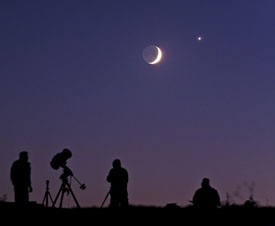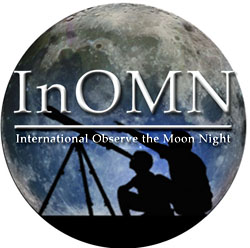International Observe the Moon Night is an event that encourages people to "look up" and enjoy our nearest neighbor. This year's InOMN is Saturday, September 6th.
Here's a quiz: What astronomical object looks amazing no matter what the magnification, never looks exactly the same no matter how often you view it, and can be observed even when not a single star is visible in the sky?
Answer: The Moon!

A crescent Moon joins Venus on the evening of September 11, 2010, as seen by skywatchers in Firuzkuh, Iran.
Babak Tafreshi / TWAN
The Moon can be a wonderful viewing target no matter what your level of experience or how well you're equipped to view the night sky. Whether seen by eye, through binoculars, or with a telescope, it's always worth a look.
So here's your chance to join a "group viewing" of our closest neighbor world: this Saturday, September 6th, is "International Observe the Moon Night." It's the brainchild of several "Moon Units" within and related to NASA: the Lunar Reconnaissance Orbiter mission, Lunar Science Institute, Lunar and Planetary Institute, and Lunar Quest. Partnering with the Astronomical Society of the Pacific, these teams hope to rekindle public interest in observing and studying the Moon.
Participation couldn't be easier: just go outside on the 6th, and look up! You'll be greeted by a lovely, not-quite-full orb seemingly gliding across the southern half of the sky throughout the night. To take the next step, join one of the many organized activities being planned; check out the event map to find one near you. As just one example, Gianluca Masi plans a live webcast of telescopic viewing (starting at 20:00 UT, or 4 p.m. EDT) using his Virtual Telescope Project.

InOMN
Or make your own event. Head for a pedestrian hotspot in your town with a telescope in tow, and crowds will surely gather for a look through the eyepiece. (Trust me: no matter how bad your light pollution, the Moon is still an arresting sight when seen telescopically.)
Even if your scope-less, the InOMN organizers have pulled together lots of entertaining online content for various sources, such as a lunar-exploration timeline, a guided tour, and a call for volunteers to help analyze NASA imagery. The event's portal at NASA's Goddard Space Flight Center is here.
If you've got the time and inclination to view the Moon multiple times in the coming weeks, I highly recommend Patrick Thibault's can't-miss Month of Moonwatching.
Want to compare the Moon's nearside and farside for yourself? Check out Sky & Telescope's terrific new lunar globes. Choose either the natural-hued Moon you see by eye or the color-coded topographic version.
 5
5
Comments
Tom Hoffelder
September 5, 2014 at 8:18 pm
I have set up a scope on Manhattan sidewalks a number of times over the last few years. I always do it around first quarter for two reasons: 1) 1st quarter is the knock-your-socks-off view of the moon and 2) it's high in the sky at sunset. The people go crazy!
Tomorrow at sunset in the Big Apple, the moon will be 93% illuminated; I guess that's better than 100%, but not much better. And it will only be 17 degrees high. Depending on where you are, it could be hours before it rises above buildings.
Have the people who created this event ever viewed the moon in a scope at 1st quarter and when full? If you are going to do this, why not do it when you get the most bang for the buck, which will result in the most psyched people?
You must be logged in to post a comment.
September 6, 2014 at 10:39 am
"Even if your scope-less..." What? Come on, this is S&T for Pete's sake. It should be "you're", as in "you are", not "your".
You must be logged in to post a comment.
Michael
September 6, 2014 at 8:27 pm
Hi
You must be logged in to post a comment.
Mike McCabe
September 7, 2014 at 9:46 am
@rocksnstars; agreed that this was an unusual choice of phase for a once a year event.
While I really like the concept of InOMN, I've tried putting something together for the past three years only to see it clouded/rained out wherever I was. I think it's hard for the concept to gain any real traction with that kind of probability of failure. I'd like to see it become InOMS, with the "S" standing for series, as in "InOMS 2014". Then develop a schedule of one viewing date per month during various phases, even full for the variety. Then those of us that are interested in sharing the moon and participating in an organized effort would surely see at least some success. And Kelley's suggestion of using a "pedestrian hotspot" is excellent - plunk down the scope and they will come. I think a worldwide effort to develop interest in observing the moon has potential, but this particular one needs more teeth.
You must be logged in to post a comment.
Anthony Barreiro
September 8, 2014 at 2:17 pm
I often set up my little refractor on the sidewalk in front of my home when the Moon is favorably placed in the evening sky (within a few days of waxing quarter), the weather is clear, and I have free time. So any night can be "Observe the Moon Night" at least on my block. I live in a city with a lot of light pollution, so the Moon is a perfect target, easily visible to people who have never looked through a telescope. People are often surprised how much detail they can see on the lunar surface.
During the months when Jupiter is high overhead in the evening, the big guy makes another great target.
You must be logged in to post a comment.
You must be logged in to post a comment.